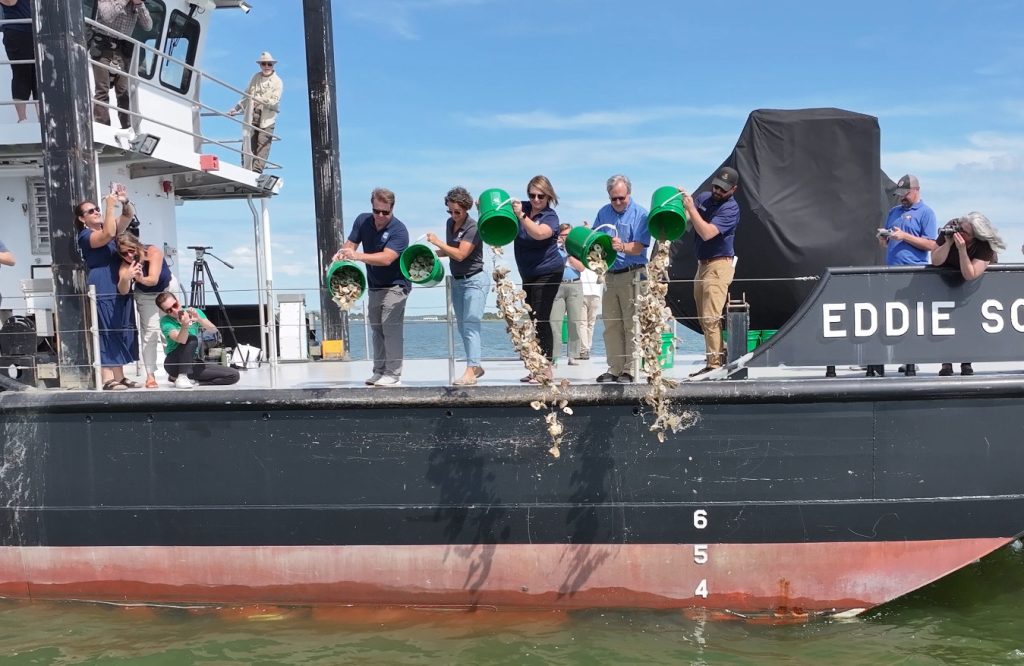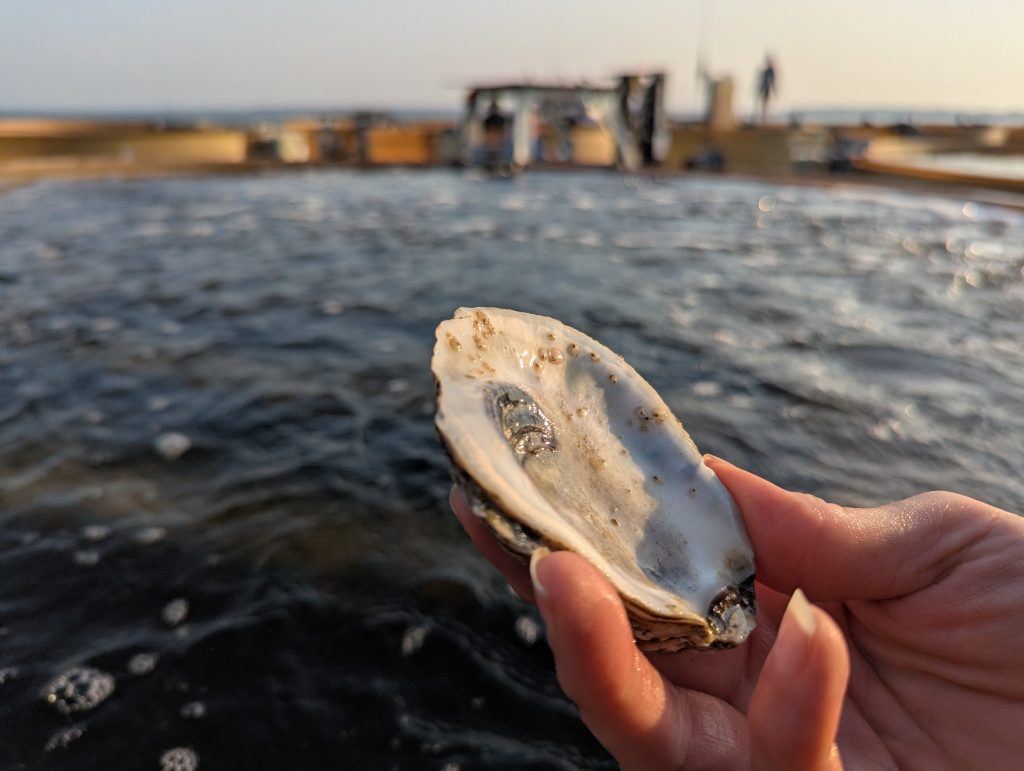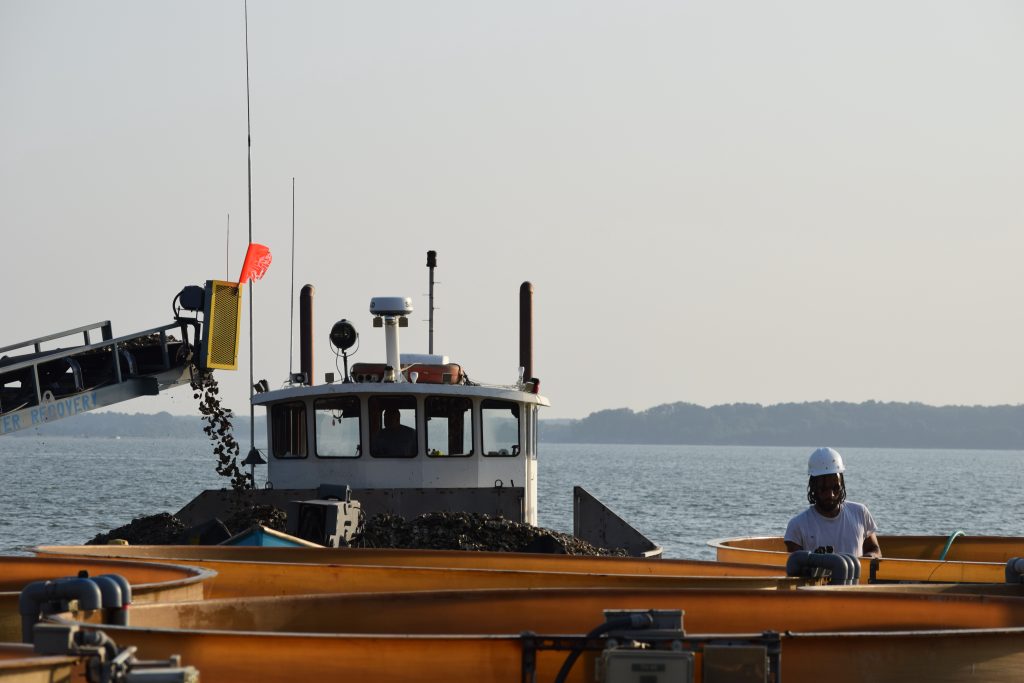The oyster restoration projects–among the largest in the world–have been highly successful at helping bring back oyster populations and build habitat in the Chesapeake Bay

Maryland Department of Natural Resources Secretary Josh Kurtz, left, added dozens of spat-on-shell oysters to the mark the completion of the Manokin River oyster restoration sanctuary together with Mike Sieracki, Director of the University of Maryland Center for Environmental Science’s Horn Point Laboratory; Allison Colden, Chesapeake Bay Foundation Maryland Executive Director; Angela Sowers, Integrated Water Resource Management Specialist at U.S. Army Corps of Engineers, Baltimore District; and Ward Slacum, Executive Director of the Oyster Recovery Partnership. Photo by Winn Brewer, Maryland DNR.
Governor Wes Moore today announced that Maryland will formally meet its commitment to restore five oyster tributaries in the Chesapeake Bay by completing oyster restoration in the Manokin River Sanctuary on the Lower Eastern Shore. The oyster restoration projects—among the largest in the world—have been highly successful at helping bring back oyster populations, building habitat and supporting economic growth in the Chesapeake Bay.
“This restoration supports our commitment to bringing the oyster population back in five rivers by 2025 and the larger effort to support the repopulation of oysters in the Chesapeake Bay, which has more than tripled in the past 20 years,” said Gov. Moore. “Our success represents the best of government collaboration to systematically address a complex environmental issue with real economic impact.”
Oysters are a key driver of Maryland’s commercial fishing industry. Average dockside value saw a more than 300 percent increase from before restoration began, with watermen bringing an average of 475,000 bushels of oysters annually for an average dockside value of more than $18 million annually during the previous five years. Prior to restoration beginning, Maryland watermen harvested an average of 116,000 bushels per year for an estimated dockside value of $3.5 million annually from 2005 to 2010.
A keystone species in the Bay, oysters are ecologically important for filtering water and providing habitat for fish and other aquatic life. The oyster restoration sanctuaries are permanently closed to harvest, except on aquaculture lease sites, and are intended as areas where oysters can grow undisturbed for their many ecological benefits. With restoration sanctuaries, scientists also hope to increase the Bay’s overall spawning stock of oysters and facilitate natural disease resistance.
Maryland Department of Natural Resources Secretary Josh Kurtz joined federal, university, and nonprofit partners for one of the final oyster deployments in the Manokin on Tuesday, adding thousands of new oysters to mark the completion of more than a decade of successful oyster restoration efforts in Maryland.
The moment in the Manokin marked the culmination of 14 years of large-scale oyster restoration in Maryland and ensured the state would meet its Chesapeake Bay Watershed Agreement commitment of restoring native oyster habitat in five tributaries by 2025. Virginia restored five tributaries in its portion of the Bay as well.
“The Manokin River sanctuary is the last phase of a decade-plus investment in oyster restoration,” said Maryland Department of Natural Resources Secretary Josh Kurtz. “Now, as we wrap up restoration here, we can see how far we’ve come. We’ve been so impressed by the success in these restoration sanctuaries. These productive oyster reefs are a testament to the hard work our staff and partners have dedicated to this effort, and they show us how oysters can thrive when we support them.”
The restoration effort was made possible through strong partnerships. The National Oceanic and Atmospheric Administration provided funds, scientific expertise, and monitoring. The U.S. Army Corps of Engineers assists with monitoring and helped build the foundation of reefs with stone, shell, and other hard substrates to better support oyster beds on Bay bottom. The University of Maryland Center for Environmental Science’s Horn Point Lab set billions of oyster shells with spat–or juvenile oysters–to seed the newly created reefs. Nonprofits including the Oyster Recovery Partnership and Chesapeake Bay Foundation distributed those young oysters throughout the underwater sanctuaries.
The Maryland General Assembly, in 2019, permanently protected the state’s oyster restoration sanctuaries from harvest, ensuring that the restored areas will serve as protected reefs and a marine refuge for generations to come. Together, the Maryland Department of Natural Resources and the federal government invested more than $92 million to restore 1,300 acres of oyster reefs in Maryland.
“The Oyster Recovery Partnership is proud of the strong partnership with the Maryland Department of Natural Resources and our shared vision to revitalize Maryland’s oyster populations,” said Oyster Recovery Partnership Executive Director Ward Slacum. “The completion of the Manokin River oyster sanctuary represents a historic achievement for Maryland and for oyster restoration globally. This significant milestone was made possible by the collaborative efforts of all involved partners, who have demonstrated an unwavering commitment to a healthier Chesapeake Bay.”
Maryland’s other completed oyster restoration sanctuaries are the Little Choptank River in Dorchester County, the St. Mary’s River in St. Mary’s County, and Harris Creek and the Tred Avon River in Talbot County. In restoration sanctuaries, scientists are finding several promising signs of long-term oyster recovery, such as the establishment of dense three-dimensional oyster reef structure, multiple age classes of oysters, increased oyster biomass, and natural reproduction. The 2025 stock assessment, which found oysters in the Maryland waters of the Bay had increased from 2.4 to 7.6 billion in 20 years, also found that the population of oysters in the area of the first three restored sanctuaries grew by a combined total of about 700 million oysters.
The Manokin River sanctuary includes 455 acres of restored oyster reefs, more than the 441 planned acres. More than 1.39 billion hatchery set oysters have been planted in the sanctuary. The Manokin was established as a sanctuary in 2010, and designated as the fifth large-scale tributary for restoration in June 2019. Restoration began in 2022, with the Department of Natural Resources overseeing the planning, design, and implementation of the project in close coordination with partners.
“We are proud of our key position in the partnership, producing juveniles to restore the Chesapeake Bay oyster populations,” said University of Maryland Center for Environmental Science Horn Point Laboratory Director Michael Sieracki.
Maryland capital funds supported the Manokin River restoration, and a NOAA grant supported larvae production. In total, as of 2024, $21.60 million has been spent on the Manokin restoration. The U.S. Army Corps of Engineers Baltimore District partnered in the planning of the Manokin blueprint and provided funding and construction support for reef restoration and monitoring of the Harris Creek and Tred Avon sanctuaries. NOAA will monitor the Manokin River after initial restoration is completed.
“The Baltimore District is proud to be part of the team that has contributed to large-scale oyster reef restoration efforts in Maryland and toward the Chesapeake Bay Program’s goal to restore oyster reefs in 10 Chesapeake Bay tributaries by 2025,” said USACE Baltimore District Commander Col. Francis Pera. “Preservation of our Bay contributes to national security by ensuring both economic and ecological vitality for those who live and work in its watershed for generations to come.”
Early monitoring results from the Manokin have been encouraging. In 2024, Maryland Department of Natural Resources staff found that the natural spat set at the Manokin was high enough that the planting of hatchery-reared spat-on-shell was not needed on 90 acres of substrate constructed reefs, saving the department $1.8 million on the restoration.
“Large-scale oyster restoration is working,” said Chesapeake Bay Foundation Maryland Executive Director Allison Colden. “In Maryland, the oyster population has tripled since 2005. And we’re excited that Maryland DNR has already committed to restore three additional oyster sanctuaries in the state. This event marks a momentous achievement, but also the beginning of the next phase of oyster restoration. We’re eager to keep up the momentum and continue our collaborative work towards a restored oyster population in Chesapeake Bay.”
Maryland is already working on the next phase of oyster restoration. DNR has selected the next three sites for large-scale oyster restoration in Maryland waters of the Chesapeake Bay, in Herring Bay, the Nanticoke River, and Hoopers Strait sanctuaries. The department is also currently planting at sites in Eastern Bay, which is a multi-use regional project that supports planting in protected sanctuaries, aquaculture lease sites, and fishery harvest areas.

Dots of spat, or juvenile oysters, are visible on an oyster shell taken from a holding tank at Horn Point Hatchery. Taken to restoration sanctuaries, these spat become the next generation of oysters. Photo by Joe Zimmermann/DNR

